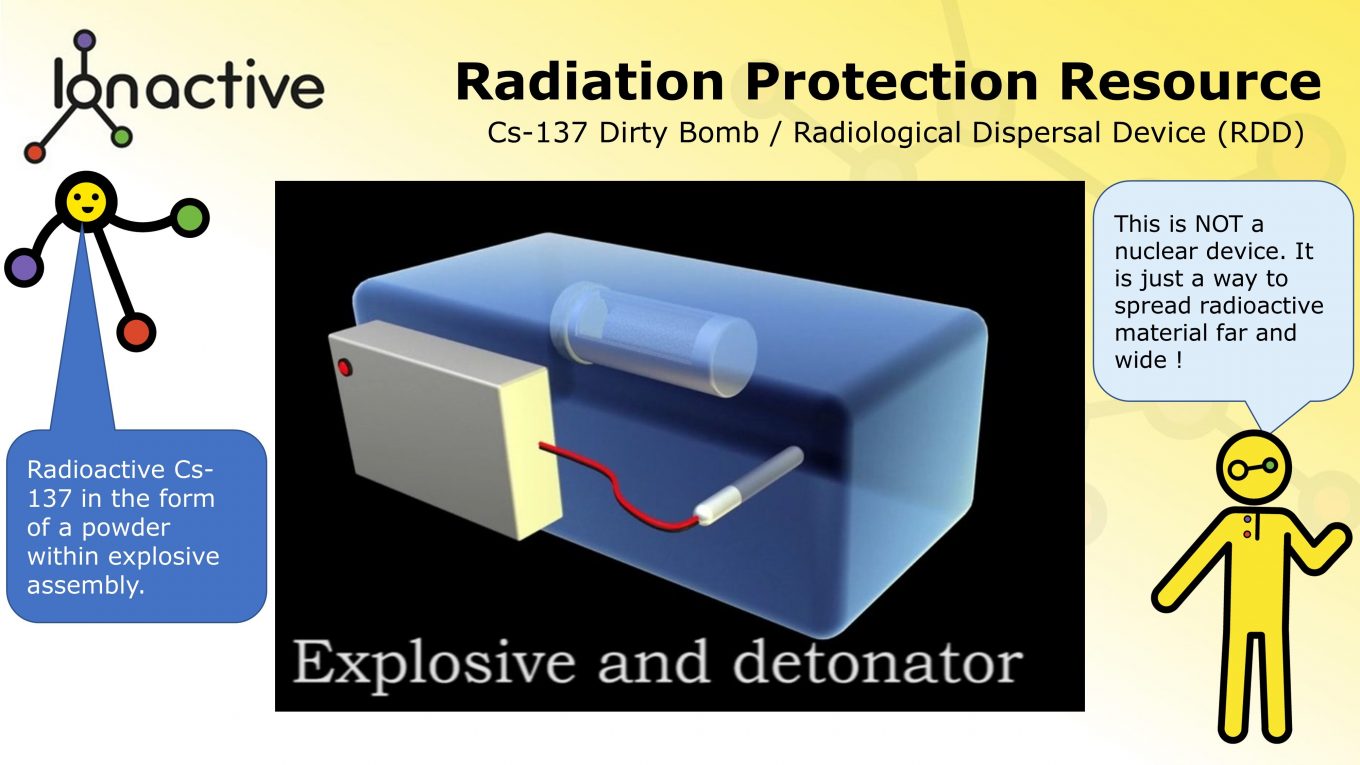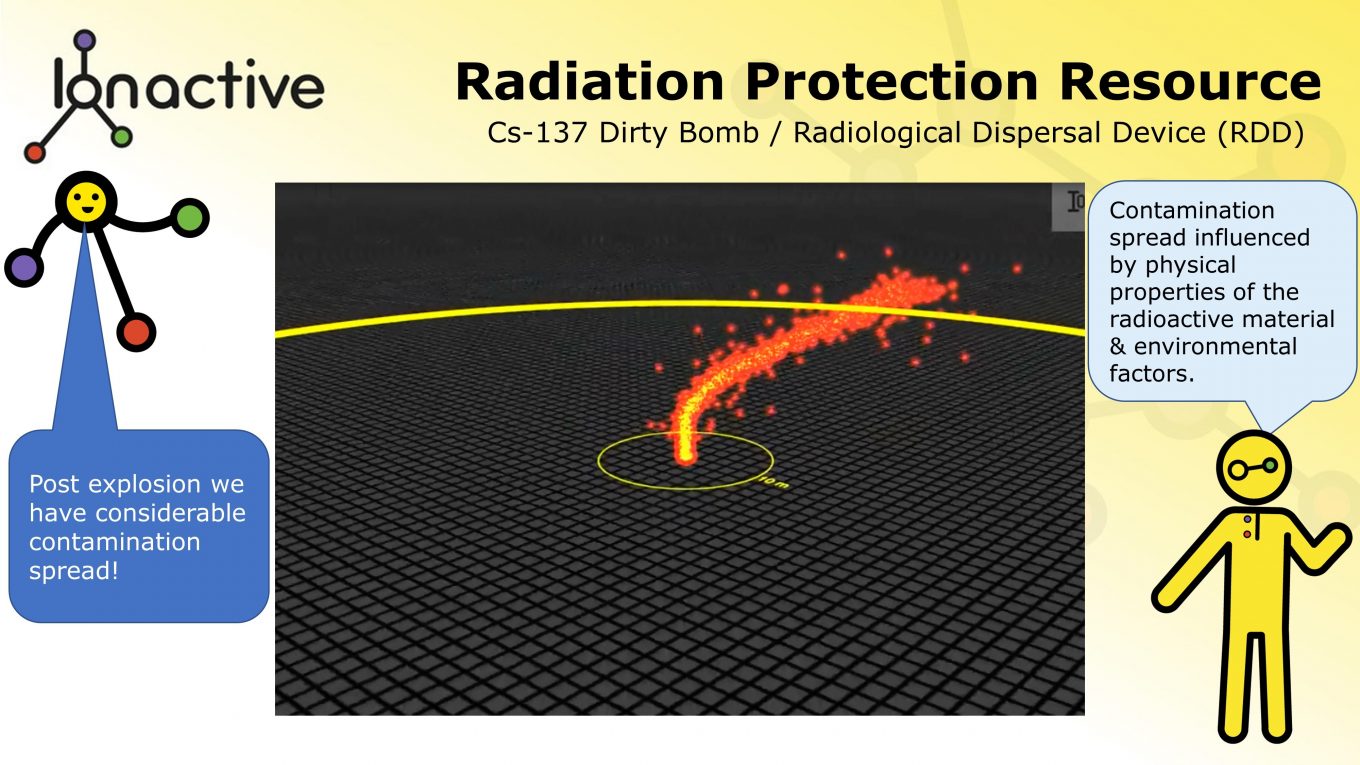What is a dirty bomb? What is its radiation significance?
Published: Sep 29, 2021
Outline
The term ‘dirty bomb’ is generally used in the media and is supposed to be emotive. The term means a device consisting of radioactive material and explosives combined together in some way. The term ‘dirty’ implies that the device contains radioactive material, whereas bomb means the device has material that will cause an explosion upon detonation.
The more ‘technical’ term used by various security services and consultants is ‘Radiological Dispersal Device’. This term, shortened to RDD and sounding more official and scientific, more accurately describes what the dirty bomb is – a device designed to spread radioactive material far and wide causing panic, closure of large areas of infrastructure (e.g. public transport) and potential health effects.
An important consideration is that the RDD (dirty bomb) is NOT a nuclear device. It cannot explode as an atomic / nuclear bomb might. The power of the RDD is governed by the quantity and type of explosive present, the presence of radioactive material has no influence on the explosion itself.
What is the dirty bomb / RDD?
The device is a rather crude / “dirty” way of spreading radioactive material around. When one considers the events of Chernobyl and Fukushima, and the resulting press coverage and anxiety (which lead for example to Germany shutting down many of its nuclear power plants), one can see why an RDD might be a ‘useful’ device for a terrorist group. Furthermore, the demise of Alexander Litvinenko is perhaps the nearest we have come in UK to the aftermath of a dirty bomb. In this case there was no explosion, but the deliberate administration of radioactive Po-210 to a person, with disregard to who else might be harmed by contamination spread, yielded anxiety among many and a hugely costly clean-up. This is different to the accidental spread of radioactive material in the above-mentioned nuclear accidents, or the spread of industrial radioactive material during the infamous Goiânia incident.
Here is a basic mock-up of a dirty bomb containing a capsule of powdered Cs-137 surrounded by explosive material.

In all cases public and governmental anxiety, and the clean-up costs (this continues at Chernobyl and Fukushima), plays into the hands of anyone who would want to cause similar levels of disruption.
During the Cold War the principle of MAD was prevalent. Mutual Assured Destruction. Perhaps a modified version of this could be used – Massive Assured Disruption. For this is really the point of the RDD / dirty bomb. The radiation health effects of such a device, when compared to a nuclear explosion, are negligible.
Where is the worst place to be around a dirty bomb?
We once asked this question to a group of police officers we were training on a CBRN course “Where is the worst place to be around an RDD”. Various answers were given including ‘downwind’ and ‘very close’. We said, ‘sat right on top of it when it goes off’. Without getting too quantitative this is a matter of fact. The explosive force will do you more damage than the radiation exposure will. This answer can be slightly modified if you happened to be sitting close to the RDD for some considerable length of time. If the radioactive material were a beta / gamma emitter (something like Cs-137 or Co-60) then you would get maximum potential external exposure since you have the maximum activity of radioactive material all in one place (i.e. inside the RDD). However, the overall risk of radiation induced health effects, as compared to the risk that the RDD will explode at any moment, are again negligible.
A radioactive contamination spreader
We have noted that the aim of the dirty bomb / RDD is to spread radioactive material far and wide (as radioactive contamination). Depending on the physical / chemical properties of the radioactive material, the nature of the explosion, the wind direction and other environmental factors, the type of area (i.e. city / town / grassland etc), the radioactive material will somehow spread far and wide. It may be blown about in the wind, settle out on flat surfaces, enter drains or ventilation systems. The one thing that is guaranteed is that the radioactivity is ‘diluted’ and this is quite an important consideration when looking at potential radiological health effects.

Let's look at some basic figures
Suppose the RDD has Cs-137 in the form of a radioactive powder. Assume that the activity of the CS-137 is 1 GBq (that is 1,000,000,000 Bq). Post blast that activity will be spread out such that you will have lower specific activities in the environment. Examples could include 10’s Bq/cm2 over a surface area, 10’s Bq/m3 in air, 10’s of Bq/g of contaminated soil and so on. The point is that however you look at it, if you have dispersed the radioactivity and if you happen to be in some a location “X”, some distance from the blast (i.e. your survived the effects of the explosion), then the radioactivity at X will be much less than the activity within the RDD before it exploded.
It therefore follows that the external radiation hazard will be considerably less than it would be if you were still sitting on top of the unexploded RDD (it is assumed the RDD does not have radiation shielding). Time is a factor here that cannot be ignored, but in the response times we are talking about after an RDD event, it has little effect oveerall. It is true that you might stay at location X longer than you would sitting upon the RDD, but reduction of activity is on your side. All other things being equal, if you are sitting within the vicinity of 1/10000 of the total radioactive content of the RDD, then the dose rate at that point can be approximated to 1/10000 of the dose rate you would be receiving if sat on top of the RDD. Let’s look briefly at some numbers.
External radiation
Dose rate sat 1 cm from 1 GBq of Cs-137 will be about 760 mSv/h (12.7 mSv/ minute). Hardly good for you (!), but not a killer either. Several hours of continuous exposure is survivable (assuming the RDD does not explode!).
Assume activity at location X to be 1/10000 of the RDD total. This is an arbitrary figure but feels about right. If you blow up a small bag of flour, think how that material would physically disperse and how long it would take you to scrape up and place all the flour back in a new bag? The dose rate at X, assuming the radioactive material be treated as a point source (unlikely but worse case) would be 76 micro Sv/h at 1 cm (so assume you are laying on the ground!). Perhaps you are actually standing up, simplifying using the same point source idea, means that your trunk (whole body dose rate) would be about 0.001 micro Sv/h (i.e. background).
There are many simplifications and assumptions here - but this crude analysis shows that the external dose rates, not very far from the site of an exploded RDD which contained a high energy / high activity beta / gamma emitters, are not that great (actually nothing to worry about compared to an explosion!). Perception of radiation risk is a totally different matter and be sure that once the nature of the incident is known the area will be emptied of all persons.
If the radioactive material were only an alpha emitter, or a low energy beta / gamma emitter then the external radiation hazard sat upon the unexploded RDD would be negligible, and even less so some distance away post explosion. We have not looked at the effect of half-life in this example, which for Cs-137 (T1/2 is 30 years) would not be a factor in the early months (or years) of a clean-up. In contrast, the ability to readily detect such contamination will be diminished and this could impact exposures as we will now see.
Internal radiation
Next, we turn to the potential for internal radiation exposure. For this we will consider inhalation of radioactive material only (ingestion, skin irradiation and entry of material through cuts in the skin will not be considered). This is much more complicated due to the number of factors involved, so we will treat this at a much-simplified level. Suffice to say any or all of the following will influence the potential internal radiation exposure:
- Radioactive material used (in this case Cs-137)
- Its physical properties (solid, powder, liquid, gas)
- Its chemical properties (e.g. soluble in water, reactive in air)
- Its biological properties (i.e. potential transmission through human body)
- The radioactive substances properties (i.e. alpha, beta, gamma, emission energies and their probabilities)
- The radiological and biological half life of the material
- The environmental factors (wind, rain, topography)
- Potential dose delivered per unit Bq (activity) inhaled or ingested
- The activity concentration (e.g. in air) at the point of intake
- The duration of intake
And so on (you get the general idea)
If external exposure assumptions were tenuous, internal exposure are even more so. For this reason, we will look at this from another angle – what intake of radioactive material would yield a certain level of radiation exposure at our point “X”. As you might now guess there are even more factors at play (pick up factors, transfer factors etc). We will simplify and just assume that a certain activity of Cs-137 taken in to the body will yield a certain whole body committed effective dose.
So, let’s state the following - broadly speaking inhaling 150 Bq of CS-137 will present a committed effective dose of 1 micro Sv. (Strictly speaking for 150 Bq to fully enter the lungs / systemic system would require more activity at the point of intake, since the human body is good at clearance - e.g. the nose). Let is not worry about this - we are just playing with some numbers.
We can scale this as follows:
1 micro Sv – 150 Bq
1 mSv – 150 KBq
Noting we said earlier that the total source term of the RDD was 1,000,000,000 Bq (1 GBq), then 1 mSv inhaled is of the order of 0.015 % of the total activity. Think back to the bag of flour. What is the activity in air at point X going to be, to deliver a dose of 1 mSv? Think about the physical spread of material.
What about inhaling 10% of the total activity? That would be inhaling 100 MBq (that is 0.1 GBq or 100,000,000 Bq). This would yield a committed dose of 667 mSv. That is a massive radiation dose, but not immediately life threatening, In fact, on this basis inhaling the entire content of the RDD is not life threatening from the internal hazard alone – the combined internal / external exposure would be … rather unfortunate. But hopefully you can also accept is totally unrealistic too!
The bottom line
The bottom line here is that an RDD / dirty bomb is very unlikely to create a situation where lives are lost from acute radiation exposure. Lives lost from statistical radiation induced cancer (stochastic radiation effects) is still a valid concern but orders of magnitude below the figures present here (probably in the background noise).
The RDD is not an effective weapon for causing mass acute radiation casualties (death). Neither is it a good weapon for causing mass statistical lives lost from radiation induced cancer either.
At best it is an emotive weapon, based on perception of radiation risk. It is a potentially powerful economic weapon as the clean up (demanded by governments and public alike) would be at immense cost. The economic effects of closing down and restricting access to several square km of the city of London would be considerable.
Credits
The dirty bomb images are taken from a video that was produced for Ionactive by Chris Robbins from Grallator. Find out more about his work here: http://www.grallator.co.uk/
